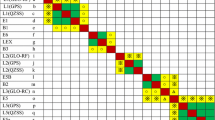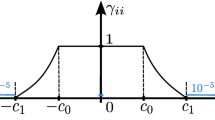Abstract
Ambiguity resolution in real-time kinematic (RTK) positioning is increasingly dependent on the combination of multi-GNSS observations, especially in challenging signal environments such as urban canyon areas. By applying a priori calibration to the receiver-dependent differential inter-system bias (DISB), a DISB-fixed multi-GNSS combination method with overlapping frequencies is widely used to strengthen the positioning model. However, as for non-overlapping frequencies, the differential inter-frequency bias (DIFB), which correlates with ambiguities, needs to be further corrected in case of the DISB-fixed multi-GNSS combination method. Since the DIFB is related to a pivot single-difference (SD) ambiguity, the DIFB is generally reduced by means of a SD ambiguity resolution. Owing to the code multipath and the code–carrier inconsistency, the traditional carrier-minus-code combination method will result in a large SD ambiguity bias and affect the DIFB correction. Thus, a SD ambiguity resolution method based on the integer least squares ambiguity estimator is proposed to deal with the issue. A kinematic experiment is conducted in urban areas, which is based on single-frequency observations from GPS L1 and BDS B1. The result shows that the proposed method can improve the performance of ambiguity resolution and positioning continuity when compared with the traditional multi-GNSS RTK methods.










Similar content being viewed by others
References
Banville S, Collins P, Lahaye F (2018) Model comparison for GLONASS RTK with low-cost receivers. GPS Solut 22:52. https://doi.org/10.1007/s10291-018-0712-3
Gao W, Meng X, Gao C, Pan S, Wang D (2018) Combined GPS and BDS for single-frequency continuous RTK positioning through real-time estimation of differential inter-system biases. GPS Solut 22:20. https://doi.org/10.1007/s10291-017-0687-5
Håkansson M, Jensen ABO, Horemuz M, Hedling G (2017) Review of code and phase biases in multi-GNSS positioning. GPS Soult 21(3):849–860
Han H, Wang J, Wang J, Moraleda AH (2017) Reliable partial ambiguity resolution for single-frequency GPS/BDS and INS integration. GPS Solut 21(1):251–264
Julien O, Alves P, Cannon ME, Zhang W (2003) A tightly coupled GPS/GALILEO combination for improved ambiguity resolution. In: Proceedings of the ENC GNSS 2003, Austrian Institute of Navigation, Graz, Austria, April 22–25, pp. 1–14
Kubo N, Tokura H, Pullen S (2018) Mixed GPS–BeiDou RTK with inter-systems bias estimation aided by CSAC. GPS Solut 22:5. https://doi.org/10.1007/s10291-017-0670-1
Leick A (1998) GLONASS satellite surveying. J Surv Eng 124(2):91–99
Li L, Li Z, Yuan H, Wang L, Hou Y (2016) Integrity monitoring-based ratio test for GNSS integer ambiguity validation. GPS Solut 20(3):573–585
Li G, Wu J, Zhao C, Tian Y (2017) Double differencing within GNSS constellations. GPS Solut 21(3):1161–1177
Li G, Geng J, Guo J, Zhou S, Lin S (2018) GPS + Galileo tightly combined RTK positioning for medium-to-long baselines based on partial ambiguity resolution. J Glob Position Syst 16(1):3. https://doi.org/10.1186/s41445-018-0011-x
Lou Y, Gong X, Gu S, Zheng F (2016) An algorithm and results analysis for GPS + BDS inter-system mix double-difference RTK. J Geod Geodyn 36(1):1–5 (in Chinese)
Odijk D, Teunissen PJG (2013) Characterization of between-receiver GPS-Galileo inter-system biases and their effect on mixed ambiguity resolution. GPS Solut 17(4):521–533
Odijk D, Nadarajah N, Zaminpardaz S, Teunissen PJG (2017) GPS, Galileo, QZSS and IRNSS differential ISBs: estimation and application. GPS Solut 21(2):439–450
Odolinski R, Teunissen PJG, Odijk D (2015) Combined BDS, Galileo, QZSS and GPS single-frequency RTK. GPS Solut 19(1):151–163
Paziewski J, Wielgosz P (2014) Assessment of GPS + Galileo and multi-frequency Galileo single-epoch precise positioning with network corrections. GPS Solut 18(4):571–579
Saastamoinen J (1973) Contributions to the theory of atmospheric refraction. Bull Géod 107:13–34. https://doi.org/10.1007/BF02522083
Schön S, Brunner FK (2008) A proposal for modeling physical correlations of GPS phase observations. J Geodesy 82(10):601–612
Teunissen PJG (1985) Generalized inverses, adjustment, the datum problem, and S-transformations. In: Grafarend EW, Sanso F (eds) Optimization of geodetic networks. Springer, Berlin, pp 11–55. https://doi.org/10.1007/978-3-642-70659-2_3
Teunissen PJG (1998) Success probability of integer GPS ambiguity rounding and bootstrapping. J Geodesy 72(10):606–612
Teunissen PJG (2010) Mixed integer estimation and validation for next generation GNSS. In: Freeden W, Nashed MZ, Sonar T (eds) Handbook of Geomathematics. Springer, Berlin, pp 1101–1127. https://doi.org/10.1007/978-3-642-01546-5_37
Teunissen PJG, Odolinski R, Odijk D (2014) Instantaneous BeiDou + GPS RTK positioning with high cut-off elevation angles. J Geodesy 88(4):335–350
Tian Y, Liu Z, Ge M, Neitzel F (2017) Determining inter-system bias of GNSS signals with narrowly spaced frequencies for GNSS positioning. J Geodesy 92(8):873–887
Wang J (2000) An approach to GLONASS ambiguity resolution. J Geodesy 74(5):421–430
Wang M, Gao Y (2007) An investigation on GPS receiver initial phase bias and its determination. In: Proceedings of the ION NTM 2007, Institute of Navigation, San Diego, CA, USA, January 22–24, pp. 873–880
Wang J, Satirapod C, Rizos C (2002) Stochastic assessment of GPS carrier phase measurements for precise static relative positioning. J Geodesy 76(2):95–104
Acknowledgements
The authors thank Dr. Gang Liu from Naval Aeronautical and Astronautical University (China) for providing the kinematic GNSS data. This research was jointly funded by the National Natural Science Foundation of China (Nos. 61773132, 61633008, 61803115), the 7th Generation Ultra Deep-Water Drilling Unit Innovation Project sponsored by Chinese Ministry of Industry and Information Technology, the Heilongjiang Province Science Fund for Distinguished Young Scholars (No. JC201809), the Fundamental Research Funds for Central Universities (No. HEUCFP201768), and the Harbin Engineering University Scholarship Fund.
Author information
Authors and Affiliations
Corresponding author
Additional information
Publisher's Note
Springer Nature remains neutral with regard to jurisdictional claims in published maps and institutional affiliations.
Rights and permissions
About this article
Cite this article
Jia, C., Zhao, L., Li, L. et al. Pivot single-difference ambiguity resolution for multi-GNSS positioning with non-overlapping frequencies. GPS Solut 23, 97 (2019). https://doi.org/10.1007/s10291-019-0891-6
Received:
Accepted:
Published:
DOI: https://doi.org/10.1007/s10291-019-0891-6




